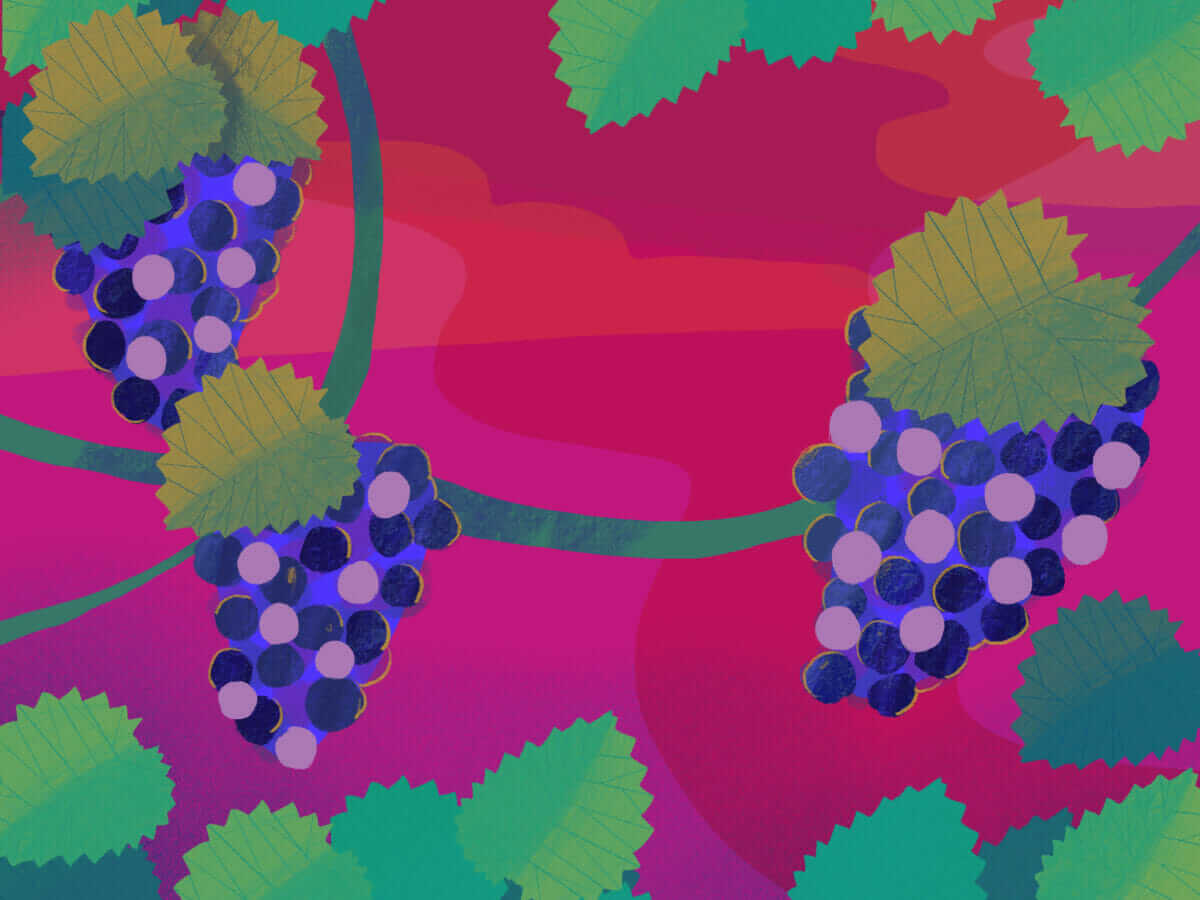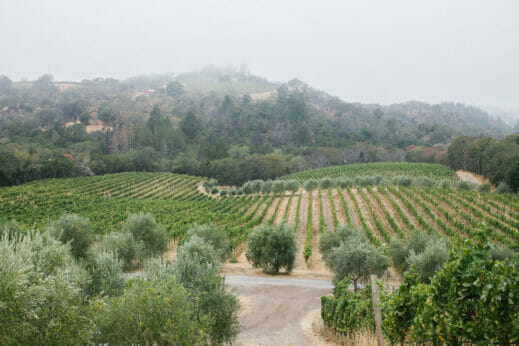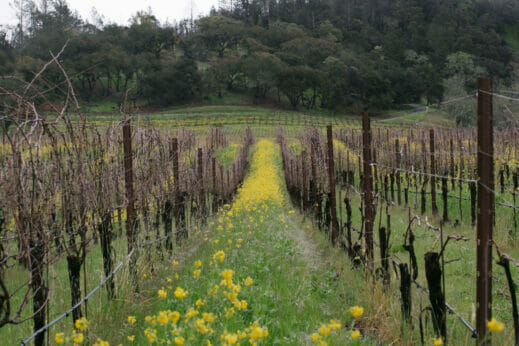The California wine industry has been rocked by years of destructive wildfires. Now, it’s working to adapt before the next big one ignites.

If you’ve perused a selection of California wines recently, you might have noticed something strange. There are 2019 vintages available and 2021 vintages, but there’s a big hole in the market where 2020 wines should be, especially Cabernet Sauvignon from Napa and Sonoma counties.
For that, blame wildfires.
Amid the pandemic lockdowns and restrictions that limited wineries’ ability to operate, drastically reducing income for regions almost completely built on tourism, Northern California’s wine country faced another enormous setback in 2020. The Glass Fire tore through Napa and Sonoma counties, on the heels of the LNU Complex Fires that decimated areas in Mendocino, Santa Cruz and Lake counties, all of which also produce wine and supply grapes to Napa and Sonoma winemakers.
Although some of Napa’s grapes had already been harvested, a huge portion of that year’s Cabernet Sauvignon, the wine for which the area is best known for and which can sell for thousands of dollars a bottle given the right year and the right winery, was lost.
Wine growers and winemakers will feel the financial impact of that loss for years to come. But as the inevitability of future wildfires becomes all too real for the state’s massive wine industry, winemakers are looking to solutions to mitigate the worst fallout in the future, from new research to technology to better land management—including embracing fire itself.
The year 2020 was California’s worst fire season on record, accounting for nearly 40 percent of the national total acreage burned for the year. In the Glass Fire, Castello di Amorosa winery in Calistoga lost 10,000 cases (120,000 bottles). Fairwinds Estate Winery next door burned to the ground, as did Chateau Boswell in St. Helena. Cain Vineyards & Winery in Sonoma lost all of its 2019 and 2020 vintages in the blaze. Thirty wineries were physically damaged, and many more were affected by smoke and had no choice but to scrap their 2020 vintage.
In a place as famous for its wine as Napa, it’s easy to assume that everything is owned by winemaking corporations with deep pockets like Gallo, but many wineries are small, family-owned businesses that rely on on-site sales for the bulk of their income.
“It’s psychologically pretty terrible because you can go through this whole growing season,” says Jim Duane, winemaker for St. Helena’s family-owned Seavey Vineyard, “starting from bud break in late February, early March and have this whole great season and then get to October when everything’s basically done, and even then it can still be ruined when fires break out.”

Vineyards can actually be helpful in stopping the spread of fire. (Photo courtesy Medlock Ames Winery)
Since 2017, there has been a catastrophic series of megafires in California’s wine country. The Tubbs Fire that year burned parts of Napa and Sonoma counties. In 2018, the Mendocino Complex Fire burned Lake County, which supplies grapes to winemakers in Napa and Sonoma, and sent smoke over the valleys. The Kincade Fire demolished parts of Sonoma in 2019. But 2020’s LNU Complex and Glass fires hit the area’s wine production hardest.
It was October, and many of the grapes had already come in for the season. Chardonnay and other white wine grapes were off the vine, their juice already fermenting in tanks. Some of the red wine grapes had come in. But Cabernet Sauvignon stays on the vine longer, and most of Napa’s Cab grapes were still ripening when the Glass Fire hit.
It’s not impossible to find California reds from 2020, and those that made it to market are exceptionally good, because of the ideal growing conditions prior to the fires. Still, Napa lost about 43 percent of its Cabernet grapes, and Sonoma lost about 30 percent of its Pinot noir grapes from the 2020 fall fires, per Wine Spectator.
But those numbers are lower than they should be. They don’t take into account grapes that were harvested and later discarded due to smoke taint.
Fires in wine regions don’t even have to touch a vineyard to destroy grapes. The smoke can do it all on its own. Grapes have thin skins that can absorb volatile phenols released into the air when trees burn. Depending on who you ask, that can be called smoke taint or smoke effect. It’s different—much more harsh and acrid—from the appealing smoky notes wine picks up from aging in toasted oak barrels.
The characteristics of smoke-tainted wine can vary, says Anita Oberholster, an enology specialist at the University of California, Davis. “Smokey is one, but it can also have a sweet barbecue character, a very medicinal character.” Oberholster is one of the world’s foremost experts on smoke taint, a new field of study and one with more questions than answers. “Can you imagine licking an ashtray? When wines are heavily impacted, it can taste like that.”
Somewhere around 20 percent of people can’t taste smoke taint, but for those who can, it’s overpowering. “It’s definitely unique,” says Oberholster. “If you’ve tasted it once, you’ll never forget it.” Part of her work is studying exactly how much smoke is still palatable to the consumer. “If we have those values, it will help winemakers make decisions about treatment options.”
Sometimes, smoke taint is easy to detect in the grapes themselves, but in other instances, it doesn’t present until wine has been fermented, and sometimes, only after it’s been aged in bottles. Currently, Oberholster is working on a collaborative project to develop a sensor network across multiple sites in California, Oregon and Washington that will measure how smoke and other volatile organic compounds affect vines. “The idea of this is [to discover whether] any of the parameters that get captured by these sensors actually correlate with smoke risk.”
If winemakers know that a certain air-quality level means smoke taint will present after fermentation, they can decide to use or scrap their grapes without the expense of harvesting and making the wine. Better access will also democratize the data, lessening the need for expensive lab tests, which can easily run in the thousands of dollars, and making it easier to provide concrete information for insurance claims.
There are developing technologies to assist growers and winemakers, such as sprays that can be applied directly to grapes to fend off smoke damage and automated systems that allow winemakers to control tanks and other equipment remotely or with reduced staff, who often need to evacuate in wildfires depending on where they live.
But it’s a three-year financial hit to lose a vintage—and that’s just if the winery is dealing with smoke taint. When actual vines burn, a vineyard will feel the effects for six or seven years: the time it takes the vines to reach maturity, and then the time to properly age the wine before it can be released. According to the California Association of Winegrape Growers, the losses from ruined or unharvested grapes in 2020 totaled $601 million. The total loss to California’s wine industry in 2020 was $3.7 billion, according to one estimate.
Because of their lush vegetation and widely spaced plants, vineyards are actually helpful in stopping the spread of fire itself, according to Richard Casale, a post-wildfire restoration specialist who works with the USDA Natural Resources Conservation Service. “Grapevines are very resilient,” he says. “I can say from experience, they do not burn easily in most cases. They’re well pruned. There’s no dead wood, and the green leaves hold a certain amount of moisture. They’re almost like mini-fire breaks on the landscape.”
Indeed, one way to avoid devastating megafires in areas such as California’s wine country may be to embrace smaller fires.
“Fire is a natural part of those ecosystems,” says Alison Blodorn, Ph.D., principal forestry program manager for the Napa County Resource Conservation District, which provides technical and financial support to the community and educates people about being better stewards of the land.
She says that much of Northern California is a “fire-adapted space,” but one that hasn’t been allowed to have smaller, naturally occurring wildfires. Those lower-intensity fires reduce the underbrush that fuels megafires.
“The situation we’re dealing with is a result of 200 years of fire suppression, which has led to overstocked forests that aren’t healthy or able to withstand fire as they should be able to,” she says. “With compounding heat and drought and other stressors, it’s created a really challenging environment.”
Napa RCD promotes conservation as a whole, but its work in fire resilience started after the 2017 wine country fires. “There’s just a huge need, particularly with so many vineyards having large amounts of forested property surrounding their vines,” says Blodorn. “Much of that forested land has not received the kind of care that it needs to be healthy and fire resilient.”
Napa RCD’s Forest Health team works with landowners to develop forest management plans and connect them to funding to implement vegetation management activities, improving the overall health and fire resilience of their forests.
“You never know when the next fire’s going to come, and we are all bracing ourselves every season,” adds Blodorn. “It can be hard for landowners because it’s not a fast process to go through, developing a plan for your property, seeking the funding, securing the funding, getting contractors out to do the work. We’re not going to fix 200 years of inaction in a year or two years. It’s really a long game that we’re playing here.”
When the Kincade Fire burned part of his property and claimed a huge portion of his 2019 harvest, Ames Morison, co-founder of Sonoma’s Medlock Ames Winery, had to do some soul searching.
“I always thought organic was the right thing and that I was doing enough, but that fire made me rethink everything,” says Morison. Most of the 340-acre ranch is undeveloped, and Morison purposely kept it that way for 25 years. “My philosophy before was, ‘let’s just let that be in its native, wild state; that’s the best way to preserve nature,’ but it’s already disturbed by our presence here. By doing nothing, it’s actually worse than actively managing it.”

Ames Morison of Medlock Ames Winery was forced to reconsider his hands-off approach after a wildfire in 2019. (Photo courtesy Medlock Ames Winery)
Morison added streamlined processes into the winery after the Kincade Fire, but his main focus has been on being a more conscientious steward of the land and understanding his role as a property owner. “It was this devastating thing, but it made us learn a lot about wildfire and why it happens and understand that it’s actually part of California’s ecology,” he says. “It’s a very powerful force, but it belongs here and we’re just in its land. We need to respect it and try to figure out how to work with it rather than fight it.”
Fred Seavey, part of the family-owned Seavey Vineyards, has a similar philosophy about ecological stewardship. After his family’s ranch burned in the 2017 Tubbs Fire, he became much more active in caring for their land. He took a forestry class at UC Davis, and worked with a registered professional forester to create a forest management plan. “Our goal is to try to make our forest more fire resilient, climate change resilient and drought resilient,” he says. For Seavey, that includes changing the footprint of the vineyards to allow sheep to graze under the vines and keep the undergrowth down, as well as creating burn piles. Last winter, he estimates he burned 225 of them across the ranch. Seavey says he intentionally kept them small, less than 20 square feet per fire, because bigger fires can create hydrophobic soil that won’t absorb water and isn’t hospitable to new growth.
He has also volunteered on prescribed burns, which eliminate vegetation under the tree canopy and reduce the risk of small fires growing out of control. Many communities in California have Prescribed Burn Associations, but Napa is just in the process of forming its association now.
“It just feels meaningful to be able to do it in a very concrete way with your own hands and see the effects on your immediate surrounding environment,” says Seavey.
To proactively protect grapes, Seavey winemaker Duane also periodically sprays his grapes with a clay mixture to prevent smoke taint and protect the grape skins—which can burn in sunlight just like a sunburn—and keep their internal temperature cooler.
In the winery, he added in newer systems to process wine, such as dedicated pumps on each tank, which make the process more automated and ensure the time-sensitive winemaking process can continue in the event that some workers can’t make it in due to fires. An issue often left out of the conversation about wildfire impact on winemaking is the crews who harvest the grapes, who make the bulk of their annual income during September and October. Winemakers and vineyard owners interviewed in this story all stressed that worker safety is paramount and they would never require employees to come to work in a dangerous situation. More automated systems can fill the gap in emergencies where a fire may be blocking the route to work or a worker’s neighborhood is being evacuated.
Fire, says Duane, “is a big problem. It’s tough to solve, but I think there’s no easy grand solution. It’s going to be people trying to do all these different individual mitigating factors.”
Casale says that he’s seeing more interest in wildfire management and restoration than ever before.
“I would say definitely there is more consciousness now,” he adds. “It’s not like fires are going away. Every year, we see the largest fires in California’s history, then the next year comes along, and then we have the next largest fire in California. We’re not seeing fires in the tens of thousands of acres. We’re seeing them in the hundreds of thousands of acres now.”
But he also sees positive momentum for the future. “I tell the growers it’s an opportunity to build back better with fire-resistant materials and to look at it in a whole new light.”
Despite many businesses investing huge amounts of time and effort into fire resistance, they’re finding it hard to maintain the insurance that will see them through a natural disaster. Many insurance companies are refusing to renew policies for vineyards that have experienced loss from wildfire, and others are increasing premiums to unaffordable levels. Jim Duane says that Seavey’s insurance tripled from 2022 to 2023, despite all of the preventative improvements.
Part of Anita Oberholster’s work, too, is establishing better information for insurance companies to utilize when offering crop insurance. “We don’t have baseline numbers for what is normal for different regions and varieties in the US,” she says. “Something we’ve been working on since 2021 is getting what is the normal range for these compounds in grapes without smoke exposure. Because we don’t have that data yet, crop insurance providers haven’t adapted their numbers because they don’t know what to adapt them to.”
“Right now, we’re in a cycle of regulate, retreat, regulate, retreat. There is this entire space in between regulate and retreat, which is partner, innovate, collaborate,” says Jennifer Gray Thompson, founder and CEO of After the Fire, a nonprofit that helps communities in Northern California rebuild by providing aid, information and resources to residents and businesses, as well as advocating for those people to policy-makers.
A large part of Thompson’s work is trying to educate insurance companies about the preventative strategies businesses are employing—everything from applying flame-resistant paint to changing landscaping away from plants that easily ignite to implementing wildfire-resistant modeling. “One of the things that insurance doesn’t recognize enough is what’s actually true about wineries and vineyards, which is that they’re great firebreaks.”
Like many others, Thompson understands that we can’t eradicate wildfire—we just need to learn better strategies to manage it.
“The number one thing for people to understand is we do have to live alongside wildfire,” she says. Accepting wildfire and working with it could be key in preventing more serious megafires. “It is an absolute necessity moving forward. We have no choice.”
This story is part of State of Abundance, a five-part series about California agriculture and climate change. See the full series here.
